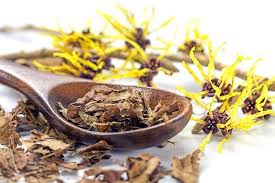
Witch Hazel Extract
What is Witch Hazel?
Witch Hazel, sometimes called Winterbloom, is a group of flowers with species found naturally in North America, Japan, and China.
The extract from witch hazel is used in many cosmetic products such as toners and essences as an astringent and vasoconstrictor. Vasoconstrictors are commonly used as anti-inflammatories and to treat redness related to swollen blood vessels. Other benefits of this ingredient include antimicrobial, antioxidant, and general anti-inflammatory properties.
Witch hazel is best for oily skin types as it is known to dry the skin by reducing the amount of sebum present on the face.
To find out if witch hazel is a good addition to your skin care routine, read below and take our skin type quiz!
How does it work?
Witch Hazel used for cosmetics is made up of many different plant compounds including polyphenols, tannins, flavonoids, gallic acid, and even essential oils.
The compounds found in witch hazel have demonstrated notable antioxidant and anti-inflammatory activity. (1)
Witch hazel is known to be a vasoconstrictor, meaning it tightens blood vessels which can reduce the appearance of swelling or redness on certain parts of the skin like the eyelids. It is also an astringent which can denature proteins and pull these proteins and water out of the skin.
Additionally, the various compounds in witch hazel have demonstrated antibacterial activity, meaning it can be useful in both preventing and treating acne and acne based inflammation. (2)
There is extensive research to support that gallic acid, one of the main components of witch hazel, is an effective binder of free radicals on the skin. (3) Free radicals are ions often caused by sun/radiation damage; these ions can lead to mutations in the genes of skin cells which can result in cancer or other genetic conditions in the long term.
Studies have found that one of the functions of witch hazel is also to passively absorb sebum while limiting its production. (4) It is often observed that applying witch hazel on the face can shrink pores, inhibiting the release of sebum onto the face. This means that overuse of witch hazel can result in dryness and irritation on the skin, so it is often used alongside a moisturizing ingredient like glycerin in cases where overly drying the skin is not desirable.
Overall, witch hazel has a few significant methods of action, from binding free radicals to reducing sebum production, eliminating bacteria, and restricting blood flow. For these reasons, witch hazel should only be included in your skin care regimen if you have oily skin and if you do not have any wounds.
how does witch hazel work?
Benefits
There are a few notable benefits associated with witch hazel in skin care; most notably antioxidant, anti-inflammatory, anti-bacterial, astringent, and sebum reducing qualities.
The antioxidant properties of witch hazel means that harmful free radicals are removed from the skin. Antioxidants are also good to use if you live in an area with high air pollution or if you are regularly exposed to smoke or fumes.
Anti-inflammatories with vasoconstricting properties are commonly used in products designed to alleviate redness and swelling in areas like the eyelids where the skin is thin and blood vessels are more likely to be visible. Many eye rescue products use ingredients like witch hazel and caffeine for that specific purpose.
The anti-bacterial nature of witch hazel means not only that it can reduce the risk of acne development, but that it can also prevent inflammation generally associated with clogged pores.
The reduction of sebum and shrinking of pores on the face generally results in a skin environment less suited to the development of comedones, meaning there is less oil on the face to clog sensitive pores.
Is it safe?
Witch hazel extracts have been found safe for use in cosmetic formulations by organizations like the Cosmetic Ingredient Review panel (CIR).
Their extensive report indicated that despite the low level of cytotoxicity and collagen synthesis inhibition, this ingredient has no long term concerns associated with its use in regulated concentrations and is not likely to cause contact issues like atopic dermatitis in individuals without an allergy to it.
If you are dealing with acne scabs, we do not recommend this ingredient for you. Check out our full explanation on why witch hazel isn’t great for pimple scabs here.
If you have a dry skin type, you likely want to avoid this ingredient and others that reduce sebum on the skin. Dry skin types need to preserve some sebum on the skin to prevent transepidermal water loss or skin barrier damage, both of which can happen when too many lipids are removed from the face.
If you have dry skin and want to use witch hazel, be sure to pair it with a moisturizing ingredient like glycerin or barrier repair ingredients like cholesterol, beta-sitosterol, ceramides, or free fatty acids.
witch hazel for acne
For acne care
Acne is a condition with a number of causes, however generally it can be understood that (besides hormones) too much sebum in combination with bacterial growth and clogged pores is the primary cause. If you have acne, witch hazel could be a great ingredient for your skin care regimen as it removes sebum from the skin. The antibacterial properties of witch hazel also means that acne causing bacteria are reduced. Some people say that witch hazel will make pimples heal faster, but this is not true. The vasoconstricting properties means that healing of scabbing from pimples or wounds healing in general can be hampered by limiting blood flow. If you have a scab or another kind of skin lesion, avoid witch hazel on that area.
If you have acne, it is important to use ingredients that prevent acne and actively work to unclog the pores. Some common ingredients for treating acne are salicylic acid, benzoyl peroxide, and retinoids.(5) Depending on your specific skin type and the severity of your acne, the best combination of ingredients for you will vary.
Witch hazel is an astringent ingredient, this means it draws moisture out of the skin and tightens pores. This can irritate some skin types.
Make sure to take our skin typing quiz so we can build you a free custom regimen to treat your acne prone skin type!
For Inflammation
The compounds present in witch hazel have demonstrated anti-irritant and general anti-inflammatory properties that are very helpful in treatments of various kinds of redness and irritating, stinging skin concerns.
Conditions like eczema which are partially categorized by inflamed skin and a damaged barrier are known to benefit from witch hazel in many cases. (6)
To state it simply, it has been found that a few of the tannins in witch hazel extract are good at telling your body not to react to certain stressors, resulting in a decreased level of inflammation on the skin. In other words, the tannins encourage your skin not to issue an immune response to specific irritants which keeps the skin from turning red, swelling, or itching. (6)
Because witch hazel dries the skin, it is not recommended to use it in isolation on inflamed skin on dry skin types. Inflammation can be caused by an imbalance of the fundamental lipids that make up the skin barrier, so including barrier repair ingredients in your regimen is important when dealing with chronic inflammation or conditions like eczema.
witch hazel for Anti-aging regimens
For anti-aging
Witch hazel has some properties that are beneficial for preventing skin aging, however it also is known to inhibit collagen synthesis, one of the critical skin compounds that helps the skin maintain youthful appearance.
One of the main causes of skin aging is genetic damage caused by free radicals; and witch hazel contains antioxidants capable of binding and eliminating free radicals. For that reason, anti-aging regimens focused on repairing sun damage can benefit from the inclusion of witch hazel.
Some other great antioxidant ingredients include Vitamin E, Vitamin C, CoEnzyme Q10, Grapeseed oil, and Resveratrol.
Conversely, the slowing down of collagen production is typically understood as undesirable for both anti-aging and wound healing concerns.
Note that this ingredient, nor any other ingredient, is capable of producing elastin.
If you are looking for the best anti-aging ingredients for your skin type, check out our dictionary of all the most common anti-aging ingredients where we categorize and explain the different kinds.
Witch hazel for dry skin
For Dry Skin
The primary concern of dry skin types is maintaining a good level of moisture on the skin to avoid things like transepidermal water loss (evaporation of moisture from the skin). Ingredients like witch hazel that limit the production of sebum while stripping existing sebum from the face are not optimal for people with dry, damaged, or otherwise flaking skin. If you have dry skin, the best ingredients for you will contain moisturizing fatty acids or have humectant properties that draw moisture onto the surface of the skin.
Some great ingredients for dry skin types can include: argan oil, sunflower oil, hyaluronic acid, glycolic acid, and many others. Check out our blogs on dry skin for a more comprehensive list of our recommended ingredients.
Oily Skin
Oily skin types tend to deal with an excess of sebum on the skin that creates an environment where acne causing bacteria can proliferate easily. An oily face is also likely to experience clogged pores. If you have oily skin, witch hazel can be helpful for removing excess sebum and limiting sebum production on the skin.
Witch hazel extract is not comedogenic.
Amongst all skin types, oily skin types benefit the most from the inclusion of witch hazel on the skin.
If you have an allergy to witch hazel, some great alternatives could be tea tree oil, peppermint oil, or even honey.
Witch hazel for oily skin
Products
Witch hazel can be found in products designed for acne prevention such as cleansers, toners, and face washes. Additionally, some anti-inflammatory products contain witch hazel.
As a vasoconstrictor, products like eye rescue creams that treat swollen blood vessels in thin areas of skin also benefit from the inclusion of this ingredient.
Here are a couple of our favorite witch hazel products.


